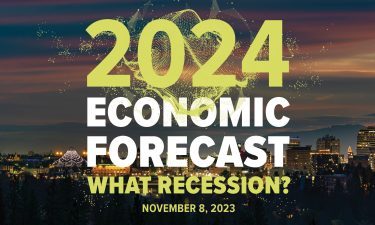
Home » Question for ’24: Why are the indicators so unclear?
Question for ’24: Why are the indicators so unclear?
Our region positioned well after doing better during pandemic, but yellow flags of caution are everywhere

November 8, 2023
I have produced annual economic reviews and forecasts for the Inland Northwest for 42 years, and in those four-plus decades I have never been less certain about where the data I follow is pointing.
Last year in this space I questioned, “Why, when so many traditional economic indicators looked so positive, are we were not feeling better about the state of our local/regional economy?”
As we approach 2024, the question is a bit different: “Why do so many economic indicators seeming so unclear, contradictory, subject to instant revision, even reversal?” It sometimes seems as if the data exhibit symptoms of “economic multiple-personality disorder” which, if not addressed early on can lead to most extreme forms of what I call “socio-political-economic bipolar syndrome.” These conditions seem to peak in both occurrence and intensity during major election years.
I have always built my annual economic reports around the answers to three questions:
First, did we grow jobs, wages, and GDP in our region’s key Metropolitan Statistical Areas (Spokane-Spokane Valley, Coeur d’Alene and Lewiston-Clarkston)?
Second, how did growth in these MSA’s compare to growth in the state, the nation and its hundreds of other MSAs?
And third, are there foreseeable regional events or factors that might cause significant variations in the way national economic activity plays out here as opposed to the rest of the nation?
I use the answers to these questions to inform my outlook for regional GDP, income, employment, income, and retail spending in the coming year.
Here’s what we know, based on my analysis of U.S. Bureau of Labor Statistics data compiled by the Seidman Research Institute at Arizona State University.
Looking at year-over year-numbers for September 2023, the Spokane-Spokane Valley MSA employed 6,700 more workers than it did a year earlier—a 2.51% gain. Meanwhile, the Coeur d’Alene MSA added 2,400 jobs (3.24%), and the region’s third and smallest MSA, Lewiston-Clarkston added 100 jobs (0.33%).
Among the nation’s 360-plus metro markets, Spokane’s job-growth ranked 84, Coeur d’Alene 38, and Lewiston 316. This regional performance compares to an all-U.S. job gain of 2.08%, and statewide gains of 2.31% and 3.2% in Washington and Idaho, respectively. In September, Idaho had the second-best job-growth rate among all states and Washington ranked 13th. The Spokane MSA continues to deal with the rare problem of having too few workers, rather than too few jobs. Wages have risen, we are seeing record and near-record employment, and are maintaining an unemployment rate around 4%, essentially full employment.
One reason for the region’s strength may lie, in part, in GDP figures. We finally have them for 2021—the year after the so-called “Year the World Shut Down.”
Based on the latest numbers, we seem to have fared significantly better than the nation. Using real-dollar changes that occurred between 2020 and 2021, as reported by the U.S. Bureau of Economic Analysis, we learn that U.S. GDP declined by 3.4%, but GDP in the Spokane MSA declined by only about 2.1%, in the Coeur d’Alene MSA by only 1.6%, and in the Lewiston-Clarkston MSA by only 0.1%.
Despite current positive numbers (most subject to revision), there are causes for concern. Signs indicate the nation’s inflation rate will moderate, but consumer confidence is more likely to moderate even more upon sighting $9-a-box cereal at the grocer’s, being handed a $13-combo meal at the drive-thru, or pumping $4-5 a gallon gas at the pump. Headlines noting that the inflation rate is moderating are cold comfort to consumers who realize their cost of necessities remains 30% to 35% above their perception of “normal.”
Interest rates are likely to keep home sales inventories low, with prices steady to slightly lower, and both external and in-market buyers more likely to adopt a “wait-and-see” attitude.
In what is certain to be a volatile election year in the U.S. and a troubling year for economic, political, and military affairs around the world, yellow flags of caution are out everywhere. The Inland Northwest has, of course, often been a haven in challenging times, and I expect we will continue to fare better here than elsewhere, as we reap the rewards of new infrastructure, growing entertainment and sports options, and build on our rich cultural and historical heritage.
Signals are emerging in the data, as well as at the drive-thru window, that American consumer enthusiasm is cooling, credit-card balances are starting to grow again despite high interest rates, and late-payments are on the rise. I am among analysts who think this is likely to cause a significant slowing of consumer spending in the coming year, and a major shift from purchases of goods to expenditure for travel, entertainment, and other experiential opportunities,
Shaun O’L. Higgins is managing principal of The Oxalis Group LLC, a Spokane consultancy focused on training, market-analysis, product development and tactical planning. He is a past chair of the Spokane Area Economic Development Council (a founding organization of Greater Spokane Incorporated). He can be reached at oxalisgroupsh@gmail.com.
Economic Forecast
Related Articles
Related Products
Related Events




